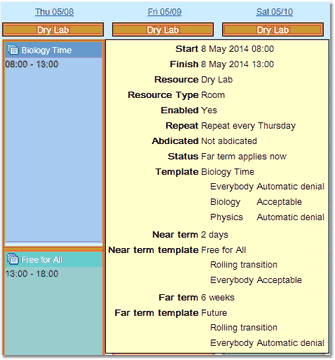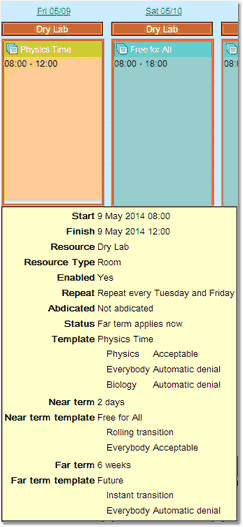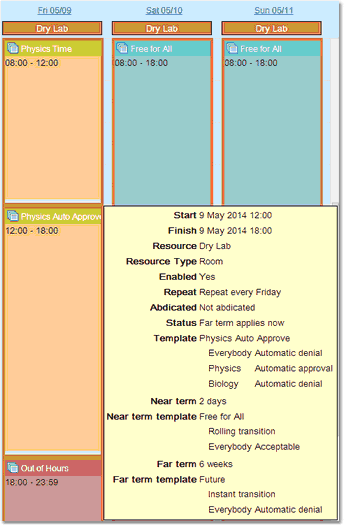Time Templates
Time Templates are a means of specifying periods of time during which different groups of people may book each resource. The Time Templates Calendar looks very much like the Bookings Calendar. The main difference is that colour no longer pertains to the resource. Instead, a Time Template specifies who can book, and that Time Template spans various periods of time. Each Time Template is given a colour, and so the colour is an indication of who can book. Time Templates cannot span multiple days.
By default, the Time Templates Calendar appears on the Calpendo menu here:
However, the administrator may have configured Calpendo so that the menu is different.
A Time Template can choose one of four possible states for a booking request:
2.Acceptable, bookings will be given the status Requested.
3.Warning, bookings will be given the status Requested but a warning message will be issued.
Hovering over the blue Time Template for Thursday morning, which is named Biology Time, shows a tooltip with the details indicating it is acceptable for Biology people to make a booking for the dry lab. This means that booking requests can be made.
It can also be seen that for Physics people and everybody else, bookings are automatically denied.
All blue items shown in this Time Templates calendar are for the same Time Template, and so the same restrictions apply.
Abdicated: This facility allows users to give up their saved time slots if they know no one will be using the resource. This means that the standard Time Template will now use the Near Term Time Template definition. Only users with the appropriate permission can abdicate a time slot and these will be set up by the administrator.
Status: This indicates which of the three possible Time Templates are currently being used for this specific time slot. They are:
|
Template: The standard Time Template with information on the restrictions enforced by the template.
Near term: A different Time Template used due to the proximity of the time slot to the current data and time, defined is when the Near Term starts.
Near term template: These define the Time Templates to be used, what time period defines near or far and the booking acceptability for different groups and how the transition is made.
Far term: A different Time Template used due to the need to restrict bookings too far in the future.
Far term template: These define the Time Templates to be used, what time period defines near or far and the booking acceptability for different groups and how the transition is made.
For more on Near and Far Term Templates see the appropriate section later in the chapter.
Note that the Time Templates Calendar does not say exactly what is meant by Biology and Physics. The names of these Time Templates should be chosen so that they are meaningful enough that everyone understands what they mean. The details of precisely what they do mean can be found by looking at Configuring Time Templates, but hopefully when a user looks at the Time Templates in Calpendo, they will understand what they mean from their name.
The Friday morning yellow Time Template, called Physics Time, indicates that Biology people are automatically denied booking the dry lab whereas Physics people are allowed to make booking requests. |
The Friday afternoon Time Template is also yellow, the same colour as Physics Time and yet it is a different Time Template and called Physics Auto Approve. This is because whoever configures the Time Templates is free to assign whatever colours they want to each Time Template. Ideally, Time Templates for the same resource would be given different colours, but it's not an absolute requirement.
Physics Auto Approve specifies that Physics people will receive automatic approval for any bookings made for the dry lab during this time. |
Near And Far Term Time Templates
Time Templates allow an administrator to specify who can use what when.
However, sometimes, it's more important to make sure that a resource is used by somebody rather than go unused because it couldn't be used by the "right" people. This is why Time Templates can be configured to mutate in the near term. For example, if by Thursday, the dry lab has no bookings for the following Friday morning, then perhaps the administrator would like to allow anybody from Physics or Biology to be allowed to book it. This is achieved by allowing the Physics Time Time Template to mutate to a more liberal Time Template within two days of the desired booking time. The tool tips above show not only what the Time Templates mean, but also what they mutate to in the near term.
It may also be important to make sure resources are not being booked too far in the future, in the hope they may be used. This is why Time Templates can be configured to mutate in the far term. For example, it may be policy that no one may book a resource more than six weeks in advance. This is achieved by allowing the Physics Time Time Template to mutate to a more restrictive Time Template if we are at least 6 weeks from the current time.
Transition allows the administrator to define how the change will take place from the Medium Term to the Near or Far Term. With Instant transition, at 9am, the whole of a Time Template from 9am to 5pm would become available for booking. With Rolling transition at 10am the portion of the Time Template from 9am to 10am would be available for booking.





